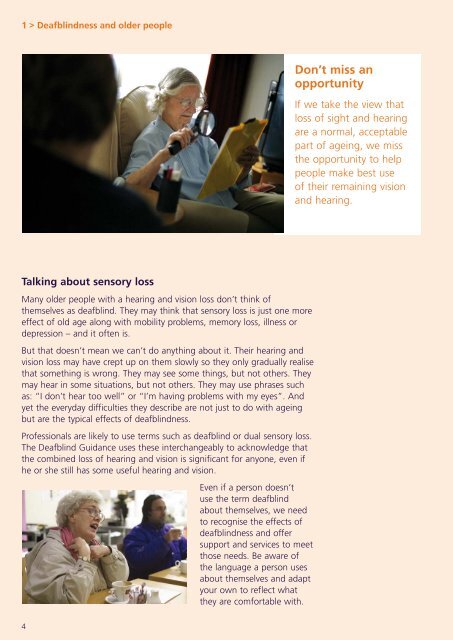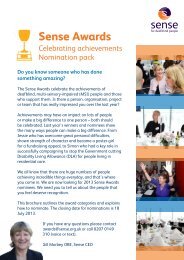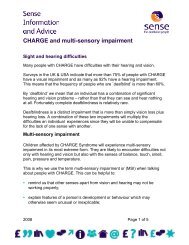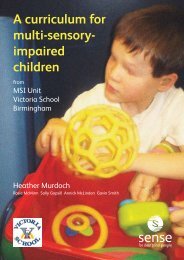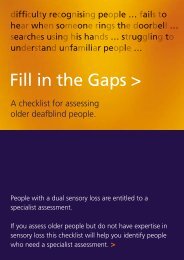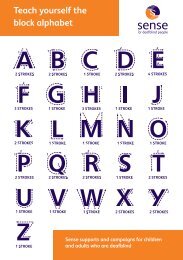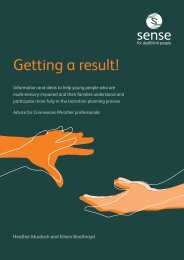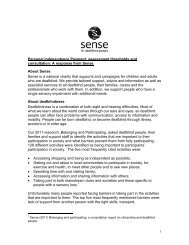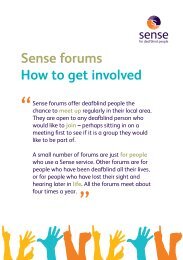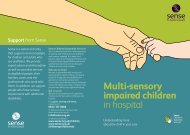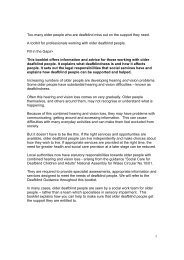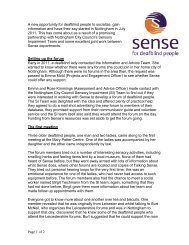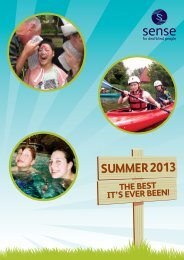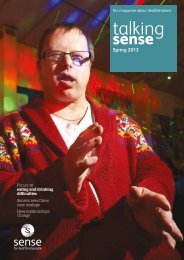Fill in the Gaps > Too many older people who are deafblind ... - Sense
Fill in the Gaps > Too many older people who are deafblind ... - Sense
Fill in the Gaps > Too many older people who are deafblind ... - Sense
You also want an ePaper? Increase the reach of your titles
YUMPU automatically turns print PDFs into web optimized ePapers that Google loves.
1 > Deafbl<strong>in</strong>dness and <strong>older</strong> <strong>people</strong>Don’t miss anopportunityIf we take <strong>the</strong> view thatloss of sight and hear<strong>in</strong>g<strong>are</strong> a normal, acceptablepart of age<strong>in</strong>g, we miss<strong>the</strong> opportunity to help<strong>people</strong> make best useof <strong>the</strong>ir rema<strong>in</strong><strong>in</strong>g visionand hear<strong>in</strong>g.Talk<strong>in</strong>g about sensory lossMany <strong>older</strong> <strong>people</strong> with a hear<strong>in</strong>g and vision loss don’t th<strong>in</strong>k of<strong>the</strong>mselves as deafbl<strong>in</strong>d. They may th<strong>in</strong>k that sensory loss is just one moreeffect of old age along with mobility problems, memory loss, illness ordepression – and it often is.But that doesn’t mean we can’t do anyth<strong>in</strong>g about it. Their hear<strong>in</strong>g andvision loss may have crept up on <strong>the</strong>m slowly so <strong>the</strong>y only gradually realisethat someth<strong>in</strong>g is wrong. They may see some th<strong>in</strong>gs, but not o<strong>the</strong>rs. Theymay hear <strong>in</strong> some situations, but not o<strong>the</strong>rs. They may use phrases suchas: “I don’t hear too well” or “I’m hav<strong>in</strong>g problems with my eyes”. Andyet <strong>the</strong> everyday difficulties <strong>the</strong>y describe <strong>are</strong> not just to do with age<strong>in</strong>gbut <strong>are</strong> <strong>the</strong> typical effects of deafbl<strong>in</strong>dness.Professionals <strong>are</strong> likely to use terms such as deafbl<strong>in</strong>d or dual sensory loss.The Deafbl<strong>in</strong>d Guidance uses <strong>the</strong>se <strong>in</strong>terchangeably to acknowledge that<strong>the</strong> comb<strong>in</strong>ed loss of hear<strong>in</strong>g and vision is significant for anyone, even ifhe or she still has some useful hear<strong>in</strong>g and vision.Even if a person doesn’tuse <strong>the</strong> term deafbl<strong>in</strong>dabout <strong>the</strong>mselves, we needto recognise <strong>the</strong> effects ofdeafbl<strong>in</strong>dness and offersupport and services to meetthose needs. Be aw<strong>are</strong> of<strong>the</strong> language a person usesabout <strong>the</strong>mselves and adaptyour own to reflect what<strong>the</strong>y <strong>are</strong> comfortable with.4


